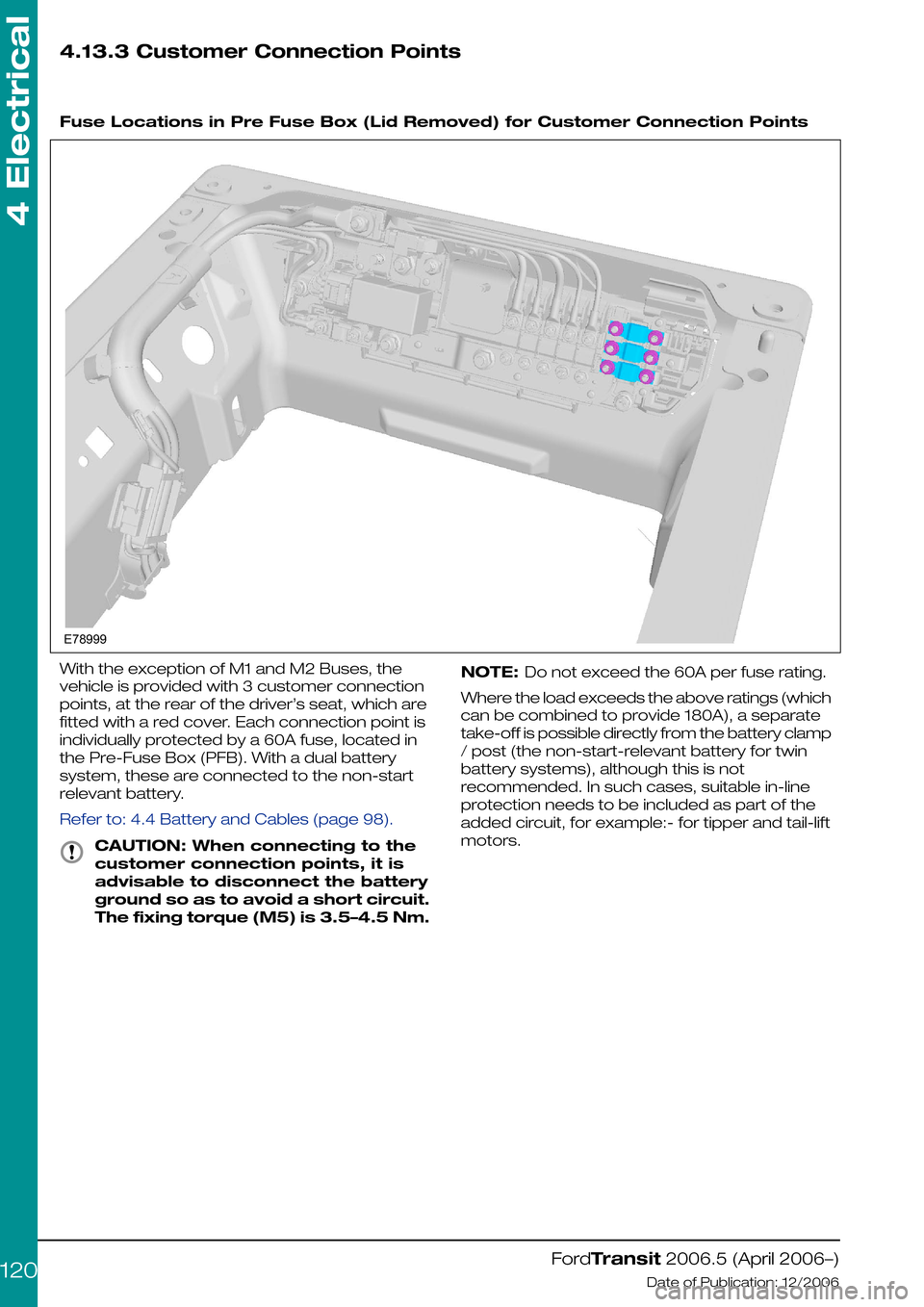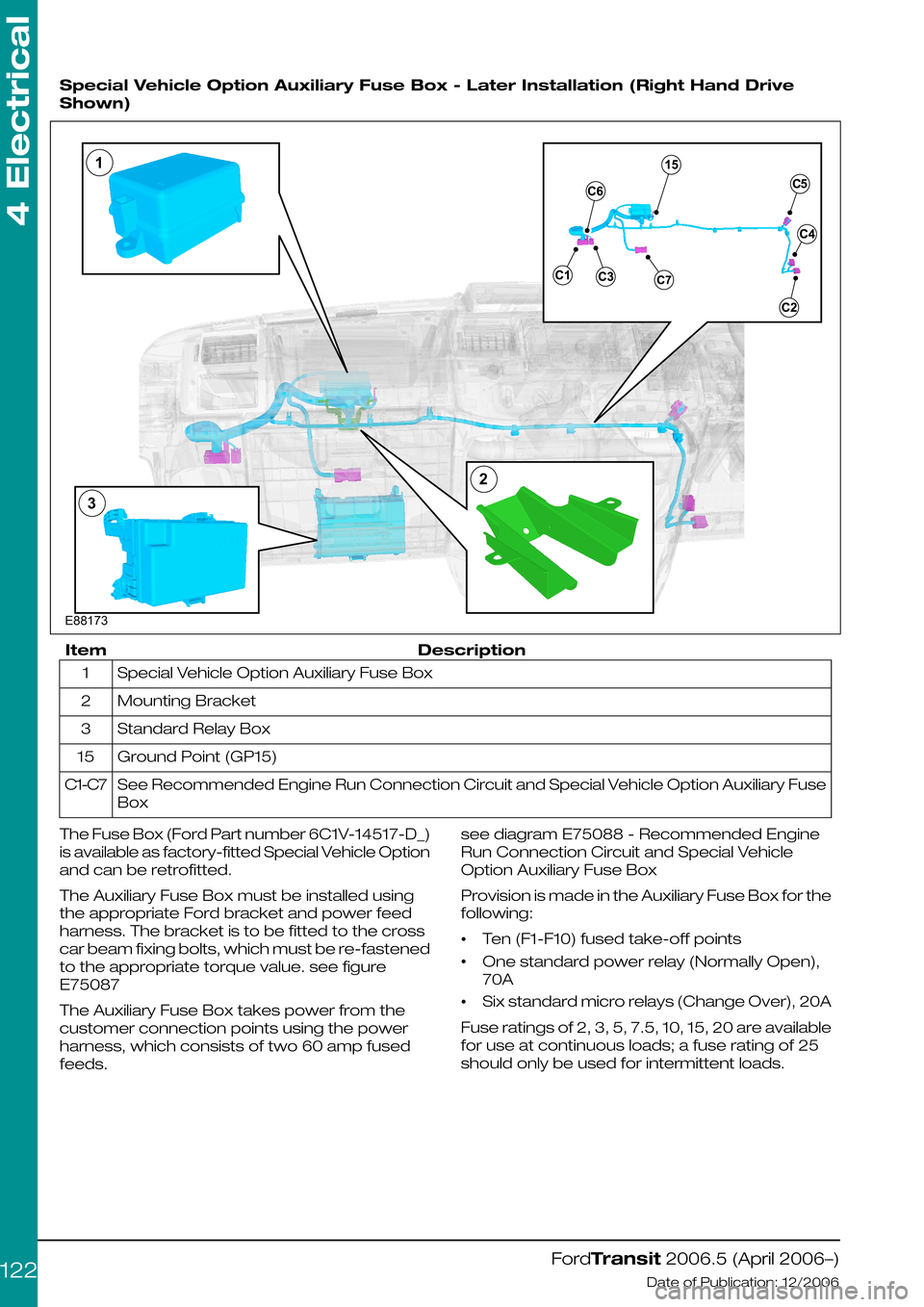2006 FORD TRANSIT fuse box
[x] Cancel search: fuse boxPage 100 of 234

Pull-in us actuvated within 70 ms of switching to
key position II
Pull-out is activated when switching to key
position I, or 0, and in key position II when no
engine run signal is sensed within 120 secs.
It is not possible to change state within 500 ms.
Removal of the Battery Disconnect
Switch (on twin battery models) and
wiring of batteries in parallel for high
current applications.
For vehicles equipped with a twin battery system,
wiring of the two batteries in parallel is not
recommended. If higher current is required,
680Ah batteries can be fitted (or a deep cycle
battery in lieu of the non-start relevant battery
only). Where a single passenger seat is fitted,
further batteries (1 or 2) can be installed in the
pedestal and added in parallel to the
non-start-relevant battery, although due
consideration then needs to be given to
increased current availability in the event of a
short circuit. Additional batteries should not be
installed under a passenger bench seat.
if this requirement is imperative, it would be
possible to disconnect the battery disconnect
switch and put the start-relevant and
non-start-relevant batteries in parallel using a
shorting bar (available from the Ford Delerships,
part number 6C1T-14A439-A*). There is one
important consideration when replacing the
battery disconnect switch with a shorting bar:
•Where the vehicle is configured for
twin-battery operation, the Central Junction
Box will detect if the battery disconnect switch
is missing (or has been removed), or the
mating connector short-circuited, and although
the vehicle will be functional, Diagnostic
Trouble Codes will be generated that will
flag-up during service. Hence if a shorting bar
is fitted, the vehicle needs to be reconfigured
(via the Dealership and Dealership Hotline).
Single to Dual Battery Conversion
For vehicles equipped with a single battery, it is
possible to upgrade to a twin battery system -
the connector for the battery disconnect switch
is present on all vehicles. In addition to
reconfiguring the vehicle for twin battery
operation (at a Dealership), the following battery
cables and components are required:
DescriptionPart Number
start relevant battery negative to vehicle ground point cable (right hand)
replaces C_ part
6C1T-14301-A_
start relevant battery negative to vehicle ground point cable (lefthand)
replaces D_ part
6C1T-14301-E_
start relevant battery negative to non-start relevant battery negative cable6C1T-14280-E_
pre-fuse box bus bar to non-start-relevant battery positive cable6C1T-14300-D_
Battery disconnect switch6C1T-10B728-A_
If a requirement exists (camper conversions for
example), it may be viable to order vehicles
installed with a single battery, a battery disconnect
switch, and a kit of harnesses – detailed above –
to be fitted by the installer.
Where required, e.g. for camper conversions,
gas-sealed battery boxes (with exterior venting)
are available. Ford part numbers:
6C1T-10N669-A_ (lefthand); 6C1T-10N669-B_
(right hand); 6C1T-10N725-A_ (lid).
The battery disconnect switch isolates the
auxiliary battery/batteries from the rest of the
base vehicle electrical system when the engine
is stopped.
The battery disconnect switch, together with
associated wiring and hardware, can be fitted as
part of an accessory kit (available from your local
Ford dealer) in the pre-fuse box.
FordTransit 2006.5 (April 2006–)
Date of Publication: 12/2006
4 Electrical
100
Page 102 of 234

Dual Battery Installation with Pre-Fuse Box and Customer Connection Points
DescriptionItem
Pre-Fuse Box1
Customer Connection Points (Not M1 or M2 buses)2
Start Relevant Battery - connection to this battery is not permitted3
Battery Access Points
For auxiliary customer loads, only connect to the
customer connection points provided (not on M1
and M2 Buses).
FordTransit 2006.5 (April 2006–)
Date of Publication: 12/2006
4 Electrical
102E74475132
Page 116 of 234

4.11 Exterior Lighting
Where the following text makes reference to the
addition of wires
Refer to: 4.14 Special Conversions (page 131).
(Adding Connectors, Terminals and Wiring)
WARNING: Make sure that the
modified vehicle complies with all
relevant legal requirements.
4.11.1 Reversing Lamps
These are hard-wired, activated by the reversing
switch on the transmission and passing through
the Central Junction Box where the signal is
sensed. A marginal increase in current (via a relay
or buffered electrical input) is permissible to
trigger a rear-view camera system, or audible
device.
4.11.2 Additional External Lamps
All power for additional exterior lamps must be
taken through the Auxiliary Fuse Box with a
suitable switch and / or relay as required.
Refer to: 4.13 Fuses and Relays (page 119).
• If CAT 6 directional indicators are to be fitted,
the Central Junction Box will need to be
configured for this.
• The load on the reversing lamps should not
exceed a total of 3A (42W).
Lighting Loads
Trailer TowLong Wheel-
base/
Extended
Frame /
Chassis Cab
/ Van
Head
Lamp
Leveling
VehicleMax.
Load
Controlling
Device
Central Junction
Box (CJB)
Outputs
-40~-2x10W60WRelay (F79)Licence Plate Supply
10W
(+2x10W)**
9W^9W15W63WRelay (F76)position Lamp Left (+
Leveling)
10W**9W^9W15W43WRelay (F75)position Lamp Right
(+ Leveling)
---21W + 21W*63WHigh Side
Driver
Direction Indication
Front Left
---21WDirection Indication
Rear Left
---21W + 21W*63WHigh Side
Driver
Direction Indication
Front Right
---21WDirection Indication
Rear Right
Symbols used
Front Dl + Turn Signal side Repeater*
Turn Signal Side Marker (5W) + Roof Marker (4W)^
6 x Side Marker (5W) + 2 x End Outline Marker (5W)~
Worst cases; left supply includes licence plate**
For trailer tow lighting relating to that system.
Refer to: 4.14 Special Conversions (page 131).
(Electrics for Tow bar)
Head Lamps
5AF75
7.5AF76
7.5AF79
FordTransit 2006.5 (April 2006–)
Date of Publication: 12/2006
4 Electrical
116
Page 118 of 234

4.12 Interior Lighting
4.12.1 Additional Internal Lamps
Additional cabin interior lighting may be obtained
by directly accessing the connector inside the
dome lamp in the cab.
Additional load space interior lighting may be
obtained by directly accessing the connector
inside the load space lamps in the load space
area.
CAUTION: The maximum total
internal lamp load must not exceed
5A (75W)
Power for the Interior Lights - cabin and
cargo areas – comes from the battery save
system (Central Junction Box pin C2-31), and for
vehicles with power locking,* the circuit for each
area is controlled by a separate pin on the Central
Junction Box:
•Front (cabin) lights, pin C2-22
•Rear (cargo) lights, pin C2-27 wire not present
on chassis cab and cab-van-floor vehicles
* with manual locking vehicles, control of interior
lighting is done directly through the door contact
switches. All vehicles, however, utilise the battery
saver relay to provide power for internal lighting
for a limited time.
Each of these pins on the Central Junction Box
can take a load of 75W. Lights that are controlled
by the battery save circuit will extinguish 30 to
180 minutes after ignition off (dependent on
vehicle configuration).
4.12.2 Additional 'Theatre
Lighting' for rear of vehicle
interior
For chassis cab or cab-van floor (and camper)
vehicles, rear lighting is not utilised and so there
is no wire to pin C2-27. However, converters can
add their own lights (up to the max. load) via the
battery save or a separate switchable feed, by
adding a pre-crimped wire and terminal to
connector C2. This is located on the Central
Junction Box behind the glove box on the
passenger side (please refer to Figures E84705
and E84712).
Refer to: 4.14 Special Conversions (page 131).
(Adding connectors, Terminals and Wiring)
Where higher wattage installations are required,
these should be taken through the Auxiliary Fuse
Box with a suitable switch and / or relay as
required.
Refer to: 4.13 Fuses and Relays (page 119).
FordTransit 2006.5 (April 2006–)
Date of Publication: 12/2006
4 Electrical
118
Page 119 of 234

4.13 Fuses and Relays
4.13.1 Wiring Specification
When designing wire installations for additional
equipment use the cable size recommended by
the equipment manufacturer or select a suitable
size from the Current Rating Wire Sizes
specifications chart.
Refer to: 4.2 (page 94).
Wiring consists a soft annealed copper core in
accordance with DIN 57201 (VDDE 0201)
sheathed in Hypalon or irradiated PVC.
For 0,5mm cable an alternative material with
conductor E-CU F20 or F21 in accordance with
DIN 40500 sheathed in cross linked PVC is
available.
4.13.2 Auxiliary Fuses, Fuse Box
and Relays (Fuses - Standard)
WARNING: No increase in existing
vehicle standard fuse capacity is
allowed under any circumstances.
There are no spare fuses in the
Engine Junction Box, Standard Relay
Box or Central Junction Box. The
vehicle converter/modifier must
provide additional fuses as required.
Please refer to below chart.
Standard Fuses
ColorTypeAmpere
Rating
Part Number
GreyMINI2A1L3T 14A094 A_
VioletMINI3A1L3T 14A094 B_
TanMINI5A1L3T 14A094 D_
BrownMINI7.5A1L3T 14A094 E_
RedMINI10A1L3T 14A094 F_
BlueMINI15A1L3T 14A094 G_
YellowMINI20A1L3T 14A094 H_
NaturalMINI25A1L3T 14A094 J_
ColorTypeAmpere
Rating
Part Number
PinkJ-CASE30AF8SB 14A094 B_
GreenJ-CASE40AF8SB 14A094 C_
YellowJ-CASE60AXS21 14A094 A_
ColorTypeAmpere
Rating
Part Number
GreenMIDI40A2S6T 14A094 B_
YellowMIDI60A2S6T 14A094 D_
BlueMIDI100A2S6T 14A094 G_
FordTransit 2006.5 (April 2006–)
Date of Publication: 12/2006
4 Electrical
119
Page 120 of 234

4.13.3 Customer Connection Points
Fuse Locations in Pre Fuse Box (Lid Removed) for Customer Connection Points
With the exception of M1 and M2 Buses, the
vehicle is provided with 3 customer connection
points, at the rear of the driver’s seat, which are
fitted with a red cover. Each connection point is
individually protected by a 60A fuse, located in
the Pre-Fuse Box (PFB). With a dual battery
system, these are connected to the non-start
relevant battery.
Refer to: 4.4 Battery and Cables (page 98).
CAUTION: When connecting to the
customer connection points, it is
advisable to disconnect the battery
ground so as to avoid a short circuit.
The fixing torque (M5) is 3.5–4.5 Nm.
NOTE: Do not exceed the 60A per fuse rating.
Where the load exceeds the above ratings (which
can be combined to provide 180A), a separate
take-off is possible directly from the battery clamp
/ post (the non-start-relevant battery for twin
battery systems), although this is not
recommended. In such cases, suitable in-line
protection needs to be included as part of the
added circuit, for example:- for tipper and tail-lift
motors.
FordTransit 2006.5 (April 2006–)
Date of Publication: 12/2006
4 Electrical
120E78999
Page 121 of 234

4.13.4 Special Vehicle Option Auxiliary Fuse Box
Special Vehicle Option Auxiliary Fuse Box - Early Installation (Right Hand Drive
Shown)
DescriptionItem
Special Vehicle Option Auxiliary Fuse Box1
Mounting Bracket2
Standard Relay Box3
Ground Point (GP15)15
See Recommended Engine Run Connection Circuit and Special Vehicle Option Auxiliary Fuse
Box
C1-C7
FordTransit 2006.5 (April 2006–)
Date of Publication: 12/2006
4 Electrical
121E75087132
Page 122 of 234

Special Vehicle Option Auxiliary Fuse Box - Later Installation (Right Hand Drive
Shown)
DescriptionItem
Special Vehicle Option Auxiliary Fuse Box1
Mounting Bracket2
Standard Relay Box3
Ground Point (GP15)15
See Recommended Engine Run Connection Circuit and Special Vehicle Option Auxiliary Fuse
Box
C1-C7
The Fuse Box (Ford Part number 6C1V-14517-D_)
is available as factory-fitted Special Vehicle Option
and can be retrofitted.
The Auxiliary Fuse Box must be installed using
the appropriate Ford bracket and power feed
harness. The bracket is to be fitted to the cross
car beam fixing bolts, which must be re-fastened
to the appropriate torque value. see figure
E75087
The Auxiliary Fuse Box takes power from the
customer connection points using the power
harness, which consists of two 60 amp fused
feeds.
see diagram E75088 - Recommended Engine
Run Connection Circuit and Special Vehicle
Option Auxiliary Fuse Box
Provision is made in the Auxiliary Fuse Box for the
following:
•Ten (F1-F10) fused take-off points
•One standard power relay (Normally Open),
70A
•Six standard micro relays (Change Over), 20A
Fuse ratings of 2, 3, 5, 7.5, 10, 15, 20 are available
for use at continuous loads; a fuse rating of 25
should only be used for intermittent loads.
FordTransit 2006.5 (April 2006–)
Date of Publication: 12/2006
4 Electrical
122E88173132